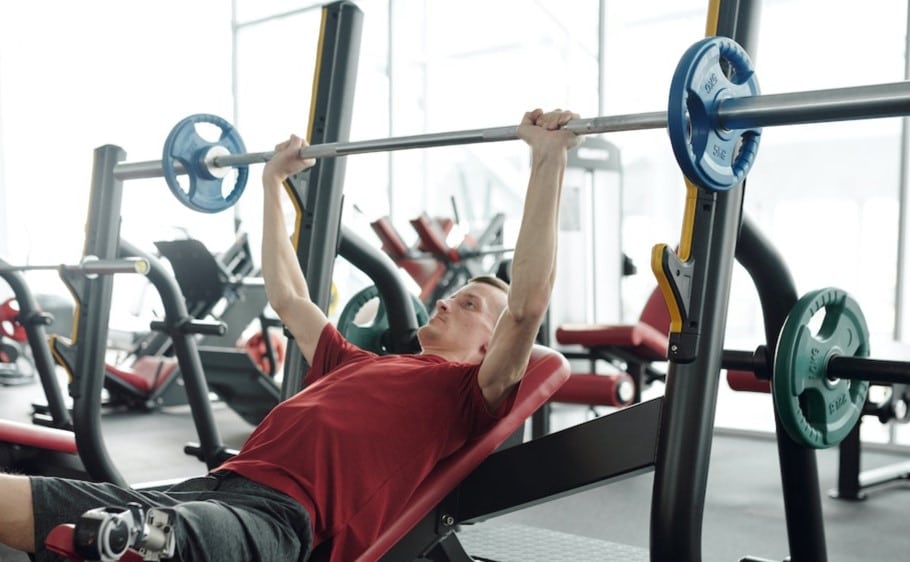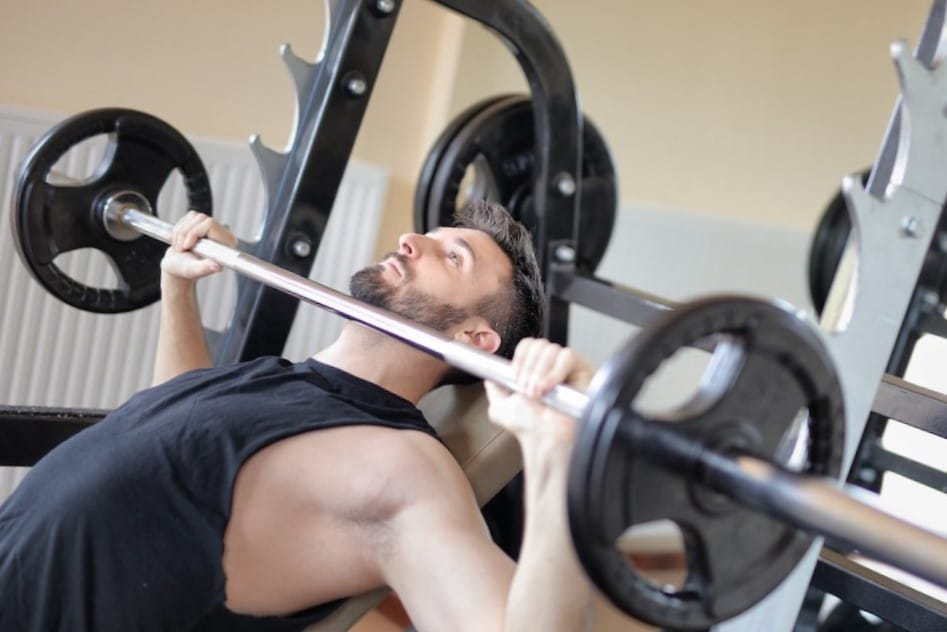Are you looking to improve your upper body strength and sculpt your chest and shoulders? The incline bench press is a go-to exercise for many fitness enthusiasts and athletes alike. Contrary to popular belief, it requires more than just brute strength. It demands precision in body positioning, grip, and technique to maximize its benefits and minimize the risk of injury.
In this article
In this blog post, we will cover the proper form, variations, tips, and more to help you master this exercise and take your upper body training to the next level. So, let’s dive in and elevate your chest and shoulder gains like never before!

What is the incline bench press?
The incline bench press is a variation of the traditional bench press exercise that targets the upper part of the pectoral muscles and the anterior deltoids. In this exercise, the bench is positioned at an angle of about 45 degrees, which creates an inclined position for the lifter. This variation of the bench press can be performed using a barbell and is a popular exercise in weightlifting and strength training routines.
How to do the incline bench press
Here is a step-by-step guide on how to perform the incline barbell bench press using a barbell:
Step 1: Set up your base
Place an incline workout bench, either on its own or in a power rack, at about 30 or 45 degrees. Make sure the bench is stable and secure.
Step 2: Position yourself on the bench
Lie flat on your back on the bench with your spine in a straight position, feet straight and flat on the floor. Draw in and brace your abs and lock your shoulder blades back and down on the bench.
Step 3: Grip the barbell
Grasp the barbell with a grip that is about 1.5 to 2 times shoulder width, ensuring that your hands are evenly distributed on the bar. The bar should be positioned at about chest level.
Step 4: Unrack the barbell
Using proper form, unrack the barbell by pushing it off the rack with controlled movements. Always use a spotter if possible for safety.
Step 5: Lower the barbell
Lower the barbell towards your chest in a controlled manner, keeping your elbows at a 90-degree angle or slightly wider. Aim to lower the barbell to your chest, just above the sternum.
Step 6: Press the barbell
Push the barbell back up towards the starting position by extending your arms, maintaining control and stability throughout the movement. Fully extend your arms, but do not lock out your elbows at the top of the movement.
Step 7: Repeat for desired reps
Perform the desired number of repetitions with proper form, maintaining control and stability throughout the exercise.

What are the different variations of the incline bench press?
The incline bench press has several variations that can be performed to target different muscles and achieve specific fitness goals. Some of the different variations include:
1. Incline barbell bench press
This is one of the most common variations of this exercise, where a barbell is used on an incline bench to target the chest, shoulders, and triceps.
2. Incline dumbbell press
This variation involves using dumbbells instead of a barbell, allowing for a greater range of motion and providing more stability challenges. It can be effective for hypertrophy and higher-rep training.
3. Incline Smith machine bench press
In this variation, a Smith machine is used instead of free weights, which provides a guided and controlled movement pattern. It can be useful for those who may need additional stability or support during the exercise.
4. Incline machine bench press
Some gyms may have machines specifically designed for this exercise, where the movement is guided and controlled using a machine. This can be helpful for beginners or those who may need additional support or assistance.
5. Incline close grip bench press
This variation involves using a narrow grip on the barbell, placing more emphasis on the triceps, while still targeting the chest and shoulders.
6. Incline reverse grip bench press
In this variation, the grip is reversed, with palms facing toward the lifter’s feet. This variation can target the upper chest and shoulders in a different way compared to the traditional incline bench press.
Watch this video called “How to Do Incline Dumbbell Bench Press ” from the Howcast channel.
What are the benefits of the incline bench press?
This popular exercise offers several benefits for strength training and muscle development. Some of the benefits include:
1. Activates multiple muscle groups
Studies have explored the effects of variations in bench press inclination and found that changing the bench press inclination, including incline bench press, can elicit regional activation of the pectoralis major muscle. This exercise also targets other muscle groups, including the anterior deltoids and triceps. This makes it an effective exercise for overall upper body strength and muscle development.
2. Less stress on the rotator cuff
Setting the bench at a 15-30% incline can reduce the stress on the rotator cuff, which is a common area for injury during the flat bench press. This makes the incline bench press a safer option for individuals who may have shoulder issues or want to reduce the risk of shoulder injuries.
3. Improves upper body strength and power
Research studies have shown that the incline bench press can lead to improvements in upper body strength and power. A study conducted on untrained young men found that the incline bench press, when combined with the horizontal bench press, resulted in significant neuromuscular adaptations, indicating increased strength and power gains.
4. Provides a challenging workout
The incline bench press can be a challenging exercise, requiring stability, control, and proper form. It can help in improving overall body coordination, balance, and stability, which can have functional benefits in daily activities and other sports.
Who should do the incline barbell bench press?
The incline bench press is generally recommended for:
1. Individuals looking to build upper body muscle
This exercise targets the chest, lats, triceps, and shoulders, making it a great exercise for building muscle in the upper body. It can be particularly beneficial for those who are looking to bulk up their physique or speed up muscular hypertrophy in the upper body.
2. Those who want to target their chest muscles
Doing this exercise can be an excellent way to specifically target the chest muscles, especially if individuals struggle to feel their pecs while performing the traditional bench press. The higher the incline of the bench, the higher the activation of the anterior deltoids, making it a suitable exercise for those looking to engage their chest muscles more effectively.
3. Individuals looking for variety in their workout routine
This exercise offers a variation from the traditional flat bench press, providing a different range of motion and muscle emphasis. This can add variety to a workout routine and help individuals target their muscles from different angles.
As with any exercise, it’s always best to consult with a qualified fitness professional or healthcare provider before incorporating the incline bench press or any new exercise into your workout routine, especially if you have any pre-existing health conditions or concerns.
Tips for beginners
If you are a beginner looking to perform an incline bench press, here are some tips to keep in mind:
1. Set up properly
Make sure to set up the incline bench at a 30–45 degree angle. Pull your shoulder blades back and squeeze them together when lying on the bench and maintain this position throughout the entire lift.
2. Use appropriate weight
Start with a weight that you can comfortably handle with proper form. Avoid going to absolute muscle failure every set, and once you hit the top of your rep range for one set, consider adding weight gradually.
3. Focus on form
Proper form is crucial for maximizing the benefits and reducing the risk of injury. Keep your back arched, feet flat on the floor, and grip the bar with a medium-width, pronated grip. Lower the bar with control to the upper part of your chest, keeping your elbows at about a 45-degree angle with your body.
4. Rest between sets
Rest for 3 to 4 minutes between each set to allow for proper recovery and performance in subsequent sets.
Frequently Asked Questions (FAQs)
Got more questions about the incline bench press exercise? Check out some commonly asked questions about this topic below.
Beginners should start with a weight that allows them to perform 8-12 repetitions with proper form and without straining. Gradually increase the weight as you get stronger and more comfortable with the exercise.
It’s important to consult with a qualified fitness professional or healthcare provider if you have any pre-existing shoulder issues. They can assess your condition and provide guidance on whether this exercise is safe for you, or if modifications or alternative exercises may be more appropriate.
The frequency can vary depending on your fitness goals, training program, and recovery abilities. As a general guideline, it’s recommended to allow at least 48 hours of rest between chest workouts to allow for proper muscle recovery. However, it’s best to consult with a fitness professional to determine the ideal frequency for your individual needs and goals.
Conclusion
So, are you ready to give it a try? Remember to start with a weight that challenges you but allows for proper form, and gradually progress as you get stronger. Don’t forget to listen to your body and consult with a fitness professional if you have any concerns or pre-existing conditions.
If you found this article helpful, share it with a friend who might benefit from it, and be sure to check out my full blog for more tips on chest workouts and other fitness topics. Stay motivated, stay consistent, and keep pushing yourself toward your fitness goals. You’ve got this!
